
The First Unitarian Society of Madison (FUS) is a Unitarian Universalist congregation in Shorewood Hills, Wisconsin. Its meeting house was designed by Frank Lloyd Wright and built by Marshall Erdman in 1949–1951, and has been designated a U.S. National Historic Landmark for its architecture. With over 1,000 members, it is one of the ten largest Unitarian Universalist congregations in the United States.
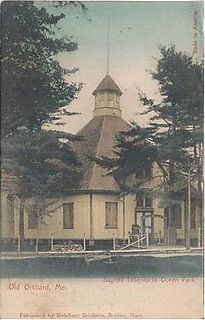
The Temple is a historic octagon-shaped Baptist church building on Temple Avenue in the Ocean Park area of Old Orchard Beach, Maine. Built in 1881, it is the centerpiece of the summer camp meeting established in 1880 by Free Will Baptists led by Bates College President Oren Cheney. It is the only known octagonal religious structure currently in use in the state. It was listed on the National Register of Historic Places in 1975, and included in the Ocean Park Historic Buildings district in 1982.

The Unitarian Universalist Church of Medford and The Osgood House are a historic Unitarian Universalist church building and parsonage house at 141 and 147 High Street in Medford, Massachusetts.

The First Congregational Church is an historic church in Stoneham, Massachusetts. Built in 1840, it is a fine local example of Greek Revival architecture, and is a landmark in the town center. It was listed on the National Register of Historic Places on April 13, 1984. The church is affiliated with the United Church of Christ; the current pastor is the Rev. Ken McGarry.
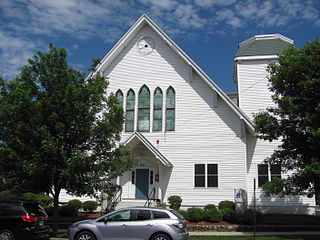
The First Unitarian Church is a historic former church building in Stoneham, Massachusetts. One of Stoneham's more stylish Gothic Revival buildings, the Stick style wood structure was built in 1869 for a Unitarian congregation that was organized in 1858. The building was listed on the National Register of Historic Places in 1984, and included in the Central Square Historic District in 1990. It presently houses the local Community Access Television organization.

The Second Unitarian Church is a historic church and synagogue building at 11 Charles Street in Brookline, Massachusetts. Built in 1916 for a Unitarian congregation, it was acquired by the innovative Reform Jewish Temple Sinai congregation in 1944. It is a high quality example of Colonial Revival/Georgian Revival architecture, and was listed on the National Register of Historic Places in 1985.

The Canaan Meetinghouse is a historic meeting house on Canaan Street in Canaan, New Hampshire. Built in 1794, with some subsequent alterations, it is a good example of a Federal period meeting house, serving as a center of town civic and religious activity for many years. The building was listed on the National Register of Historic Places in 1972, and included in the Canaan Street Historic District the following year. The building is still owned by the town, and is available for rent.

The Unitarian Church is a historic church on Exeter Road in Hampton Falls, New Hampshire. Built in 1838, it is a rare example of an in antes Greek Revival temple front in the state, and is distinguished by the presence of Victorian trompe-l'œil panels and ribbing on its interior walls. The church was listed on the National Register of Historic Places in 1984. It is presently used for services in the summertime.
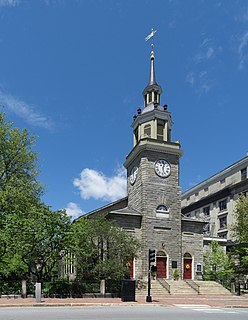
First Parish Church is an historic church at 425 Congress Street in Portland, Maine. Built in 1825 for a congregation established in 1674, it is the oldest church building in the city, and one of its finest examples of Federal period architecture. It was listed on the National Register of Historic Places in 1973. The congregation is Unitarian Universalist; its pastor is Reverend Christina Sillari.
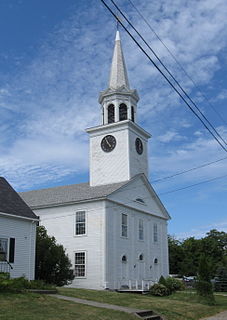
The Central Congregational Church is a historic church at 26 Middle Street in Eastport, Maine, USA. The meeting house was built in 1829, and is a remarkably sophisticated example of Federal style architecture for what was then a frontier community. It was listed on the National Register of Historic Places in 1976.

The New Sharon Congregational Church is a historic church at 21 Cape Cod Hill Road in New Sharon, Maine. Built in 1845, this brick structure is an example of Greek Revival architecture, and stands as a focal point of the rural town's center. The building was listed on the National Register of Historic Places in 1985. The church is affiliated with the United Church of Christ.

The Old Union Meetinghouse, now the Union Baptist Church, is a historic church at 107 Mason Road in the Farmington Falls area of Farmington, Maine. Built in 1826–27, it is a high-quality and well-preserved example of a traditional late-colonial meetinghouse with Federal-style details. The building was listed on the National Register of Historic Places in 1973.

The Universalist Unitarian Church is a historic church on Silver Street and Elm Street in Waterville, Maine in the United States. Built in 1832 for a Universalist congregation founded in 1826, it is a prominent local example of transitional Federal-Gothic Revival architecture. It was listed on the National Register of Historic Places in 1978.

The Centre Village Meeting House is a historic meeting house (church) on New Hampshire Route 4A in Enfield Center, New Hampshire. Built in 1836, it is a well-preserved late example of Federal period church architecture, albeit with some Greek Revival stylistic elements. Then as now, it serves as a nondenominational building, serving a variety of small Christian congregations. The building was listed on the National Register of Historic Places in 1985.
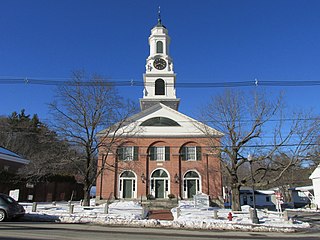
The Peterborough Unitarian Church, also once known as the First Church in Peterborough, is a historic church at Main and Summer streets in Peterborough, New Hampshire. Built in 1825-26 for a congregation founded in 1752, it is one of the state's finest examples of a Federal period church, drawing inspiration from the publications of Asher Benjamin. The building was listed on the National Register of Historic Places in 1973.

First Congregational Church, U.C.C. is a historic church building off NE 31C in Naponee, Nebraska.

The Housatonic Congregational Church is a historic church building at 1089 Main Street in Great Barrington, Massachusetts. Built in 1892 it is a prominent local example of Queen Anne Revival architecture, and was listed on the National Register of Historic Places in 2002. It is now home to the Unitarian Universalist Meeting of South Berkshire.
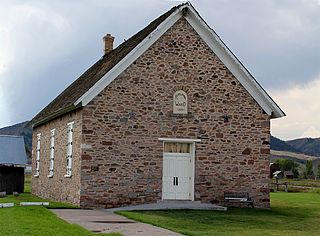
The Rock Church of Auburn, Wyoming is a historic church building that has served also as a community center. Also known as Latter Day Saints Auburn Ward Meeting House, it is located at Second W and First S Sts. in Auburn. It was built in 1889 out of stone, which, in the Star Valley in which it is located, is rarely used in architecture. It is a steeply gabled structure, of size approximately 30 by 15 feet.

The Winchester Memorial Church, also known as the New Hampshire Conservatory of Music and the Arts, is a historic civic building in the center of Winchester, New Hampshire, United States. Built in 1912, it is a prominent local example of Colonial Revival architecture. It replaced a meeting house that was the location of the Winchester Profession, a key development in the history of Unitarian Universalism. The building was listed on the National Register of Historic Places in 1980. It was acquired in 2006 by the Universalist Heritage Foundation as a memorial to the site's role in Universalist history.

The town hall of Winchester, New Hampshire, is located on Main Street, just south of the junction of New Hampshire Route 10 and New Hampshire Route 119 in the center of the town. Built of brick in 1911-12 to a design by S. Winthrop St. Clair, it is the only Gothic Revival town hall in Cheshire County. It was built because the previous town meeting house was destroyed by fire. The church was also designed by St. Clair, a Boston-based architect who hailed from Winchester.






















